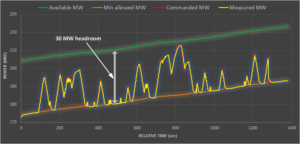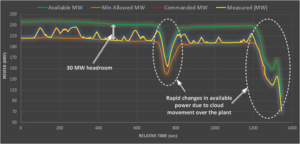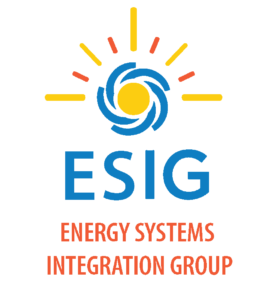With an increasing share of variable generation on the grid, traditional power generation resources equipped with automatic generation control and automatic voltage regulation controls are being displaced. To support grid stability and reliability, deployment of PV power plants that incorporate advanced grid services capability becomes increasingly essential. Recognizing this need, CAISO with support from NREL & First Solar, ran a set of tests on a 300MW utility-scale PV plant to measure its ability to provide ancillary services to the grid.
CAISO published the results quantifying the performance of a utility-scale PV plant to provide services that range from spinning reserves, load following, voltage support, ramping, frequency response, variability smoothing and frequency regulation to power quality. Specifically, the tests conducted included various forms of active power controls such as automatic generation control (AGC) and frequency regulation, and droop response, as well as reactive power/voltage/power factor controls.
 As an example, the attached figure demonstrates the plant’s nearly perfect ability to follow the CAISO’s four-second AGC dispatch signal within its selected regulation range of 30 MW, or 10% of rated plant power. The plant was commanded to curtail its production to a lower level (orange trace) that was 30 MW below its available peak power. The AGC signal was then fed to the power plant controller (red trace), so the plant output (yellow trace) was changing following the set point while the plant output was increasing during the morning period.
As an example, the attached figure demonstrates the plant’s nearly perfect ability to follow the CAISO’s four-second AGC dispatch signal within its selected regulation range of 30 MW, or 10% of rated plant power. The plant was commanded to curtail its production to a lower level (orange trace) that was 30 MW below its available peak power. The AGC signal was then fed to the power plant controller (red trace), so the plant output (yellow trace) was changing following the set point while the plant output was increasing during the morning period.
 In another example, shown in the attached figure, the plant demonstrates the AGC performance even under plant output variability due to cloud movement that causes the peak power to reduce significantly with the AGC set point being adjusted as needed.
In another example, shown in the attached figure, the plant demonstrates the AGC performance even under plant output variability due to cloud movement that causes the peak power to reduce significantly with the AGC set point being adjusted as needed.
 CAISO measures the accuracy of a resource’s response to EMS signals during 15-minute intervals by calculating the ratio between the sum of total 4-second set point deviations and the sum of AGC set points. As shown in the attached chart, the solar PV resource performed with much higher accuracy than conventional resources in following 4-second regulation dispatch signals − about 24-30 basis points better than fast gas turbine technologies. This performance is a reflection of the underlying fast responding power electronics technology deployed in PV inverters along with well designed power plant controllers. The data from these tests will be used by the CAISO in future ancillary service market design for determining the resource-specific expected mileage for the purposes of awarding Regulation Up and Regulation Down capacity.
CAISO measures the accuracy of a resource’s response to EMS signals during 15-minute intervals by calculating the ratio between the sum of total 4-second set point deviations and the sum of AGC set points. As shown in the attached chart, the solar PV resource performed with much higher accuracy than conventional resources in following 4-second regulation dispatch signals − about 24-30 basis points better than fast gas turbine technologies. This performance is a reflection of the underlying fast responding power electronics technology deployed in PV inverters along with well designed power plant controllers. The data from these tests will be used by the CAISO in future ancillary service market design for determining the resource-specific expected mileage for the purposes of awarding Regulation Up and Regulation Down capacity.
In a previous blog, Charlie Smith had written about capabilities of wind and solar plants to provide ancillary services and a call to action for all new resources to have capabilities to support grid reliability. In a following blog, Mark Ahlstom reported on how these changes are well underway. The results described here clearly demonstrate that utility-scale PV plants are not only capable of providing essential reliability services that can enhance system flexibility and reliability without incurring carbon emissions but can perform even better than conventional plants . With ever decreasing cost of solar electricity, the opportunity cost associated with some curtailment to provide services like up regulation will reduce as well.
Mahesh Morjaria
VP – PV Systems
First Solar

Leave a Reply